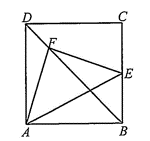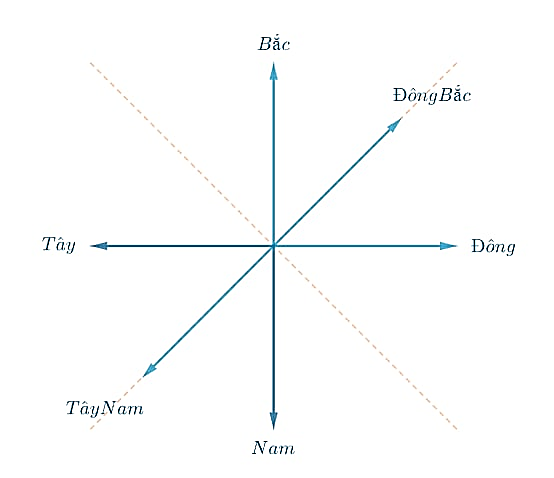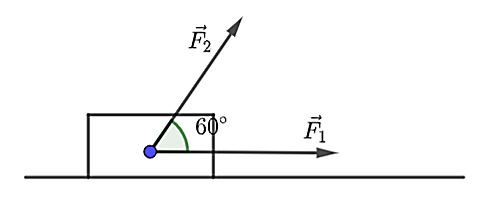Cho tam giác \(ABC\) vuông tại \(A\) có \(AB = a,BC = 2a\).
a) \(\widehat {ACB} = 60^\circ \).
b) \(\overrightarrow {BA} \cdot \overrightarrow {BC} = {a^2}\).
c) \(\overrightarrow {BC} \cdot \overrightarrow {CA} = 3{a^2}.\)
d) \(\overrightarrow {AB} \cdot \overrightarrow {BC} + \overrightarrow {BC} \cdot \overrightarrow {CA} + \overrightarrow {CA} \cdot \overrightarrow {AB} = - 4{a^2}\).
Cho tam giác \(ABC\) vuông tại \(A\) có \(AB = a,BC = 2a\).
a) \(\widehat {ACB} = 60^\circ \).
b) \(\overrightarrow {BA} \cdot \overrightarrow {BC} = {a^2}\).
c) \(\overrightarrow {BC} \cdot \overrightarrow {CA} = 3{a^2}.\)
d) \(\overrightarrow {AB} \cdot \overrightarrow {BC} + \overrightarrow {BC} \cdot \overrightarrow {CA} + \overrightarrow {CA} \cdot \overrightarrow {AB} = - 4{a^2}\).
Quảng cáo
Trả lời:
a) Sai. Xét tam giác vuông \(ABC\) có: \(AC = \sqrt {B{C^2} - A{B^2}} = \sqrt {{{\left( {2a} \right)}^2} - {a^2}} = a\sqrt 3 \),
\(\cos \widehat {ABC} = \frac{{AB}}{{BC}} = \frac{a}{{2a}} = \frac{1}{2}\) \( \Rightarrow \widehat {ABC} = 60^\circ \Rightarrow \widehat {ACB} = 30^\circ \).
b) Đúng. Ta có \(\overrightarrow {BA} \cdot \overrightarrow {BC} = \left| {\overrightarrow {BA} } \right| \cdot \left| {\overrightarrow {BC} } \right| \cdot \cos \left( {\overrightarrow {BA} ,\overrightarrow {BC} } \right) = BA \cdot BC \cdot \cos \widehat {ABC} = a \cdot 2a \cdot \frac{1}{2} = {a^2}\).
c) Sai. Ta có \(\overrightarrow {BC} \cdot \overrightarrow {CA} = - \overrightarrow {CB} \cdot \overrightarrow {CA} = - \left| {\overrightarrow {CB} } \right| \cdot \left| {\overrightarrow {CA} } \right|\cos \widehat {ACB}\)
\( = - CB \cdot CA \cdot \cos 30^\circ = - 2a \cdot a\sqrt 3 \cdot \frac{{\sqrt 3 }}{2} = - 3{a^2}.\)
d) Đúng. Vì tam giác \(ABC\) vuông tại \(A\) nên \(\overrightarrow {CA} \cdot \overrightarrow {AB} = 0\).
Ta có \(\overrightarrow {AB} \cdot \overrightarrow {BC} = - \overrightarrow {BA} \cdot \overrightarrow {BC} = - {a^2},\overrightarrow {BC} \cdot \overrightarrow {CA} = - 3{a^2}\).
Suy ra \(\overrightarrow {AB} \cdot \overrightarrow {BC} + \overrightarrow {BC} \cdot \overrightarrow {CA} + \overrightarrow {CA} \cdot \overrightarrow {AB} = - {a^2} - 3{a^2} = - 4{a^2}\).
Hot: 1000+ Đề thi cuối kì 1 file word cấu trúc mới 2025 Toán, Văn, Anh... lớp 1-12 (chỉ từ 60k). Tải ngay
- Sách - Sổ tay kiến thức trọng tâm Vật lí 10 VietJack - Sách 2025 theo chương trình mới cho 2k9 ( 31.000₫ )
- Trọng tâm Toán, Văn, Anh 10 cho cả 3 bộ KNTT, CTST, CD VietJack - Sách 2025 ( 13.600₫ )
- Sách lớp 10 - Combo Trọng tâm Toán, Văn, Anh và Lí, Hóa, Sinh cho cả 3 bộ KNTT, CD, CTST VietJack ( 75.000₫ )
- Sách lớp 11 - Trọng tâm Toán, Lý, Hóa, Sử, Địa lớp 11 3 bộ sách KNTT, CTST, CD VietJack ( 52.000₫ )
CÂU HỎI HOT CÙNG CHỦ ĐỀ
Lời giải
a) Đúng. Ta có \(\overrightarrow {AE} = \overrightarrow {AB} + \overrightarrow {BE} = \overrightarrow {AB} + \frac{1}{2}\overrightarrow {BC} = \overrightarrow {AB} + \frac{1}{2}\overrightarrow {AD} \).
b) Sai. \(\overrightarrow {AF} = \overrightarrow {AB} + \overrightarrow {BF} = \overrightarrow {AB} + \frac{3}{4}\overrightarrow {BD} = \overrightarrow {AB} + \frac{3}{4}\left( {\overrightarrow {AD} - \overrightarrow {AB} } \right) = \frac{1}{4}\overrightarrow {AB} + \frac{3}{4}\overrightarrow {AD} .\)
c) Đúng. \(\overrightarrow {EF} = \overrightarrow {AF} - \overrightarrow {AE} = \left( {\frac{1}{4}\overrightarrow {AB} + \frac{3}{4}\overrightarrow {AD} } \right) - \left( {\overrightarrow {AB} + \frac{1}{2}\overrightarrow {AD} } \right) = \frac{{ - 3}}{4}\overrightarrow {AB} + \frac{1}{4}\overrightarrow {AD} .\)
d) Đúng. Ta có \(\overrightarrow {AF} \cdot \overrightarrow {EF} = \left( {\frac{1}{4}\overrightarrow {AB} + \frac{3}{4}\overrightarrow {AD} } \right) \cdot \left( {\frac{{ - 3}}{4}\overrightarrow {AB} + \frac{1}{4}\overrightarrow {AD} } \right)\)
\( = \frac{{ - 3}}{{16}}{\overrightarrow {AB} ^2} - \frac{1}{2}\overrightarrow {AB} \cdot \overrightarrow {AD} + \frac{3}{{16}}{\overrightarrow {AD} ^2} = 0 \Rightarrow AF \bot EF{\rm{. }}\)
Ta có \({\overrightarrow {AF} ^2} = {\left( {\frac{1}{4}\overrightarrow {AB} + \frac{3}{4}\overrightarrow {AD} } \right)^2} = \frac{1}{{16}}{\overrightarrow {AB} ^2} + \frac{3}{8}\overrightarrow {AB} \cdot \overrightarrow {AD} + \frac{9}{{16}}{\overrightarrow {AD} ^2} = \frac{5}{8}{\overrightarrow {AB} ^2}\).
\({\overrightarrow {EF} ^2} = {\left( {\frac{{ - 3}}{4}\overrightarrow {AB} + \frac{1}{4}\overrightarrow {AD} } \right)^2} = \frac{9}{{16}}{\overrightarrow {AB} ^2} - \frac{3}{8}\overrightarrow {AB} \cdot \overrightarrow {AD} + \frac{1}{{16}}{\overrightarrow {AD} ^2} = \frac{5}{8}{\overrightarrow {AB} ^2}.\)
\( \Rightarrow {\overrightarrow {AF} ^2} = {\overrightarrow {EF} ^2} = \frac{5}{8}{\overrightarrow {AB} ^2} \Rightarrow AF = EF\). Vậy tam giác \(AEF\) vuông cân tại \(F\).
Lời giải
Ta có \[\overrightarrow a \cdot \overrightarrow b = \left| {\overrightarrow a } \right| \cdot \left| {\overrightarrow b } \right| \cdot \cos \left( {\overrightarrow a ,\overrightarrow b } \right) = 3 \cdot 2 \cdot \cos 120^\circ = - 3\].
\[{\left| {\overrightarrow a - 2\overrightarrow b } \right|^2} = {\left( {\overrightarrow a - 2\overrightarrow b } \right)^2} = {\overrightarrow a ^2} - 4\overrightarrow a \cdot \overrightarrow b + 4{\overrightarrow b ^2} = {\left| {\overrightarrow a } \right|^2} - 4\overrightarrow a \cdot \overrightarrow b + 4{\left| {\overrightarrow b } \right|^2} = {3^2} - 4 \cdot \left( { - 3} \right) + 4 \cdot {2^2} = 37\]
\[ \Rightarrow \left| {\overrightarrow a - 2\overrightarrow b } \right| = \sqrt {37} \approx 6,1\].
Đáp án: 6,1.
Lời giải
Bạn cần đăng ký gói VIP ( giá chỉ từ 199K ) để làm bài, xem đáp án và lời giải chi tiết không giới hạn.
Lời giải
Bạn cần đăng ký gói VIP ( giá chỉ từ 199K ) để làm bài, xem đáp án và lời giải chi tiết không giới hạn.
Câu 5
Lời giải
Bạn cần đăng ký gói VIP ( giá chỉ từ 199K ) để làm bài, xem đáp án và lời giải chi tiết không giới hạn.
Câu 6
Lời giải
Bạn cần đăng ký gói VIP ( giá chỉ từ 199K ) để làm bài, xem đáp án và lời giải chi tiết không giới hạn.
Lời giải
Bạn cần đăng ký gói VIP ( giá chỉ từ 199K ) để làm bài, xem đáp án và lời giải chi tiết không giới hạn.


